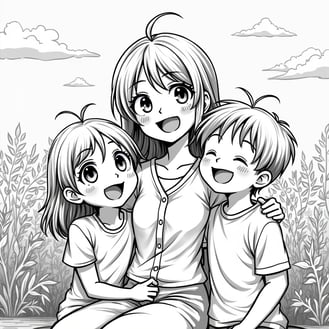How to Use Coloring Pages in Early Childhood Education
Coloring is more than just a fun and creative activity for young children—it’s a powerful educational tool that can support their development in many ways. When used thoughtfully, coloring pages can help children build important skills, from motor coordination to cognitive and emotional growth. Let’s explore how you can use coloring pages effectively in early childhood education and the benefits they offer in this crucial stage of learning.
10/1/20243 min ler
Coloring is more than just a fun and creative activity for young children—it’s a powerful educational tool that can support their development in many ways. When used thoughtfully, coloring pages can help children build important skills, from motor coordination to cognitive and emotional growth. Let’s explore how you can use coloring pages effectively in early childhood education and the benefits they offer in this crucial stage of learning.



1. Developing Fine Motor Skills
One of the most significant benefits of coloring for young children is the improvement of their fine motor skills. Holding crayons or colored pencils helps strengthen the small muscles in their hands, which are essential for writing, cutting, and other tasks that require precision. As children learn to control their movements and stay within the lines, they develop better hand-eye coordination, preparing them for more advanced skills.
To support this development, you can offer age-appropriate coloring pages with larger shapes and simpler designs for younger children. As they improve, you can introduce more detailed images to challenge their abilities.
2. Introducing Colors and Shapes
Coloring pages are a fantastic way to teach children about colors and shapes in a hands-on, engaging way. For younger kids, you can start by focusing on basic colors, encouraging them to identify and name the colors they are using. As they grow, you can introduce color mixing, teaching them how primary colors combine to create new ones.
Similarly, you can use coloring pages to help children recognize and learn shapes. Pages featuring circles, squares, triangles, and other geometric forms allow children to become familiar with these shapes in a fun context. You can even turn coloring time into a mini-lesson by asking children to point out and name the shapes before coloring them.
3. Enhancing Creativity and Imagination
Coloring allows children to tap into their creativity and imagination, giving them the freedom to explore color choices and artistic expression. While some children might enjoy staying within the lines and following patterns, others might love experimenting with unusual color combinations or adding their own details to the images.
Encourage this sense of exploration by offering open-ended prompts, like asking, "What color do you think a unicorn would be?" or "Can you color this flower in a way that no one else has before?" By giving them the space to make their own creative choices, you foster independent thinking and imagination.



4. Building Focus and Patience
For many young children, sitting down to color can help them practice focus and patience. Coloring is an activity that requires concentration, as they work to fill in spaces and complete a picture. While young children might only color for a few minutes at a time, gradually increasing the length and complexity of coloring sessions helps build their ability to stay focused on tasks.
This can be particularly helpful in preparing them for more structured learning experiences, such as reading and writing, where sustained attention is key. To support their focus, start with short, simple coloring activities and gradually extend the time as their attention span grows.
5. Learning New Concepts
Coloring pages can also be a fun way to introduce and reinforce educational concepts. For example, you can use themed coloring pages to teach lessons on animals, nature, or the alphabet. A coloring page featuring a zoo scene can spark discussions about different animals, their habitats, and sounds, while a page with letters can help children practice recognizing and naming them.
By connecting the coloring activity to a broader lesson, you can make learning more engaging and interactive. Children are more likely to remember information when it’s tied to a hands-on, creative experience.
6. Encouraging Emotional Expression
For young children, coloring can be a way to express their emotions and develop emotional intelligence. Sometimes, children may find it hard to put their feelings into words, but they can communicate through colors and images. A child might choose soft, calming colors when feeling happy or use more intense, darker colors when upset.
You can support this emotional expression by allowing children to choose their colors freely and by providing open-ended coloring activities. Coloring can also serve as a calming activity, helping children process their emotions after a busy day or when they’re feeling overwhelmed.
Tips for Using Coloring Pages in Early Childhood Education
Use Themed Coloring Pages: Tie coloring activities to the topics you’re teaching. For example, use animal-themed pages when teaching about wildlife, or alphabet coloring sheets to reinforce letter recognition.
Encourage Group Coloring: Coloring doesn’t have to be a solo activity. Encouraging group coloring helps children practice social skills like sharing, taking turns, and cooperating with others.
Pair Coloring with Storytelling: After children finish coloring, ask them to tell a story about their picture. This strengthens both their creativity and language development.
Incorporate Learning: Use coloring pages to introduce new words and concepts. For instance, while coloring a scene with trees, you can talk about nature, seasons, or the parts of a tree.
Coloring pages are a versatile and powerful tool in early childhood education. They help children develop essential skills like motor coordination, focus, and creativity, all while making learning fun and engaging. By incorporating coloring into your teaching strategy, you can foster a love for learning while supporting children’s physical, emotional, and cognitive growth. So the next time you hand out coloring pages, know that you’re doing much more than just keeping kids busy—you’re helping them grow and thrive!
All Coloring
Gallery of free coloring pages to print.
Ads
© 2024. All rights reserved.
